
Atlantic County is a county located along the Jersey Shore in the U.S. state of New Jersey. As of the 2020 census, the county was the state's 15th-most-populous county, with a population of 274,534, a drop of 15 from the 2010 census count of 274,549. Its county seat is the Mays Landing section of Hamilton Township. The county is part of the South Jersey region of the state.
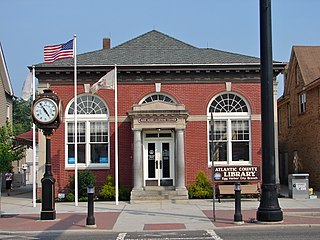
Egg Harbor City is a city in Atlantic County, New Jersey, United States. As of the 2020 United States census, the city's population was 4,396, an increase of 153 (+3.6%) from the 2010 census count of 4,243, which in turn reflected a decline of 302 (−6.6%) from the 4,545 counted in the 2000 census.

Saranac Lake is a village in the state of New York, United States. As of the 2020 census, the population was 4,887, making it the largest community by population in the Adirondack Park. The village is named after Upper, Middle and Lower Saranac lakes, which are nearby.

Peace Pilgrim, born Mildred Lisette Norman, was an American spiritual teacher, mystic, pacifist, vegetarian activist and peace activist. In 1952, she became the first woman to walk the entire length of the Appalachian Trail in one season. Starting on January 1, 1953, in Pasadena, California, she adopted the name "Peace Pilgrim" and walked across the United States for 28 years, speaking with others about peace. She was on her seventh cross-country journey when she died.

Cape May consists of a peninsula and barrier island system in the U.S. state of New Jersey. It is roughly coterminous with Cape May County and runs southwards from the New Jersey mainland, separating Delaware Bay from the Atlantic Ocean. The southernmost point in New Jersey lies on the cape. A number of resort communities line the Atlantic side of the cape, including Ocean City, the most populous community on the cape, The Wildwoods, known for its architecturally significant hotel district, and the city of Cape May, which has served as a resort community since the mid-1700s, making it the oldest such resort in the U.S.
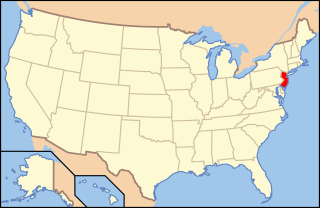
The following is an alphabetical list of articles related to the U.S. state of New Jersey.
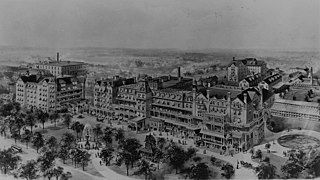
The Battle Creek Sanitarium was a world-renowned health resort in Battle Creek, Michigan, United States. It started in 1866 on health principles advocated by the Seventh-day Adventist Church and from 1876 to 1943 was managed by Dr. John Harvey Kellogg.

New Jersey is a state in the Mid-Atlantic and Northeastern regions of the United States, ratified by both states after the New York – New Jersey Line War, which is its only straight line border.

The Hudson River Waterfront Walkway, also known as the Hudson River Walkway, is a promenade along the Hudson Waterfront in New Jersey. The ongoing and incomplete project located on Kill van Kull and the western shore of Upper New York Bay and the Hudson River was implemented as part of a New Jersey state-mandated master plan to connect the municipalities from the Bayonne Bridge to the George Washington Bridge with an urban linear park and provide contiguous unhindered access to the water's edge.
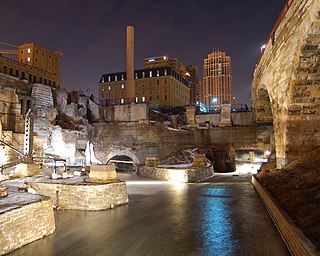
Mill Ruins Park is a park in downtown Minneapolis, Minnesota, United States, standing on the west side of Saint Anthony Falls on the Mississippi River and running from 3rd Ave. S. to about 9th Ave. S. The park interprets the history of flour milling in Minneapolis and shows the ruins of several flour mills that were abandoned.

Between 1873 and 1945, Saranac Lake, New York, became a world-renowned center for the treatment of tuberculosis, using a treatment that involved exposing patients to as much fresh air as possible under conditions of complete bed-rest. In the process, a specific building type, the "cure cottage", developed, built by residents seeking to capitalize on the town's fame, by physicians, and often by the patients themselves. Many of these structures are extant, and their historic value has been recognized by listing on The National Register of Historic Places.
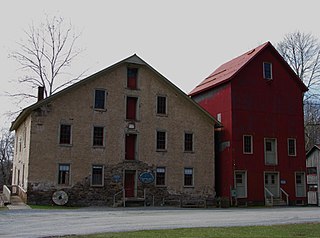
Prallsville is an unincorporated community located along New Jersey Route 29 by the border of Stockton and Delaware Township in Hunterdon County, New Jersey. The Delaware River and Wickecheoke Creek border the community. The Prallsville District was listed on the National Register of Historic Places in 1979.

The Cape May Historic District is an area of 380 acres (1.5 km2) with over 600 buildings in the resort town of Cape May, Cape May County, New Jersey. The city claims to be America's first seaside resort and has numerous buildings in the Late Victorian style, including the Eclectic, Stick, and Shingle styles, as well as the later Bungalow style, many with gingerbread trim. According to National Park Service architectural historian Carolyn Pitts, "Cape May has one of the largest collections of late 19th century frame buildings left in the United States... that give it a homogeneous architectural character, a kind of textbook of vernacular American building."

The Adirondack Cottage Sanitarium was a tuberculosis sanatorium established in Saranac Lake, New York in 1885 by Dr. Edward Livingston Trudeau. After Trudeau's death in 1915, the institution's name was changed to the Trudeau Sanatorium, following changes in conventional usage. It was listed under the latter name on the National Register of Historic Places in 1995.
Weymouth was a schooner that carried coal on the Great Egg Harbor River. She was built in 1868 as a 60-ton, two-masted schooner by carpenter Samuel Gaskill at what is now Gaskill Park, Mays Landing, New Jersey. She was used to ship charcoal and other goods produced in the Pine Barrens along the Atlantic coast until the early 1890s, when she was left tied to a dock, as was common with retired merchant ships at the time. She came loose from her dock on the Great Egg Harbor River and ran aground on tidal mud flats about a mile downstream; her owners, lacking the money to move her, abandoned her.

Ottari Sanitarium, also known as the Coburn Apartments, is a historic building complex located at 491 Kimberly Avenue in Asheville, Buncombe County, North Carolina. The original section was built in 1912, and now forms the east end of the building. It is a three-story, stuccoed brick building with a hipped roof. It was enlarged in 1923, with the addition of a three-story, 14 bay brick addition, connected to the original building by a two-story section. The building was converted to apartments in 1937.
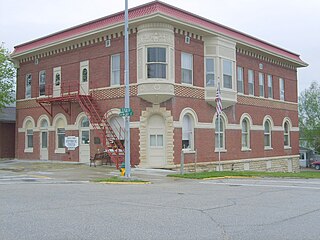
Maple View Sanitarium, also known as Community Hospital, Good Samaritan Nursing Home, and the Fayette County Historical Center, is a historic building located in West Union, Iowa, United States. It was built by Dr. Frank Beach Whitmore in 1903. The facility could accommodate 12 to 15 patients, it had its own operating room, and office. There was also a general store located in the commercial space on the main floor. Because medical care in a hospital was new in the community, it did not succeed and it folded in 1905. Whitmore left to become a missionary in China. The building housed professional offices and retail businesses until 1914 when the Nurses' Benevolent Association under the auspices of the Seventh-day Adventist Church bought the building for a hospital. It was more successful as a hospital the second time, and it was acquired by the city for a community hospital in 1920. After a new hospital building was constructed in 1951, the Good Samaritan Society bought the building for a nursing home. By 1973 changes in state law no longer made operating a nursing home here feasible. The Fayette County Historical Society acquired the building in 1975 for its use, and it operates a local history museum in the building. It was individually listed on the National Register of Historic Places in 1998. In 2015 it was included as a contributing property in the West Union Commercial Historic District.

The Ocean City Life-Saving Station is the only life-saving station of its design in New Jersey still in existence. Designed by architect James Lake Parkinson in a Carpenter Gothic style, the building is one of 25 stations built of the 1882 life-saving type. It is also one of six still in existence in the country. Construction on the facility began in September 1885 and was completed in the following year. There were two earlier stations in the northern end of Ocean City before this facility was constructed, and there were two stations farther south on the island.

The Egg Harbor Commercial Bank is a historic brick building located at 134 Philadelphia Avenue in Egg Harbor City in Atlantic County, New Jersey. Built in 1896, it was added to the National Register of Historic Places on August 28, 2007, for its significance in economics. It later served as the city hall of Egg Harbor City from 1954 to 1978. The building now is a branch of the Atlantic County Library.






















